Unit 5 What are the shirts made of 知识点讲解课件(共63张PPT)
文档属性
| 名称 | Unit 5 What are the shirts made of 知识点讲解课件(共63张PPT) | 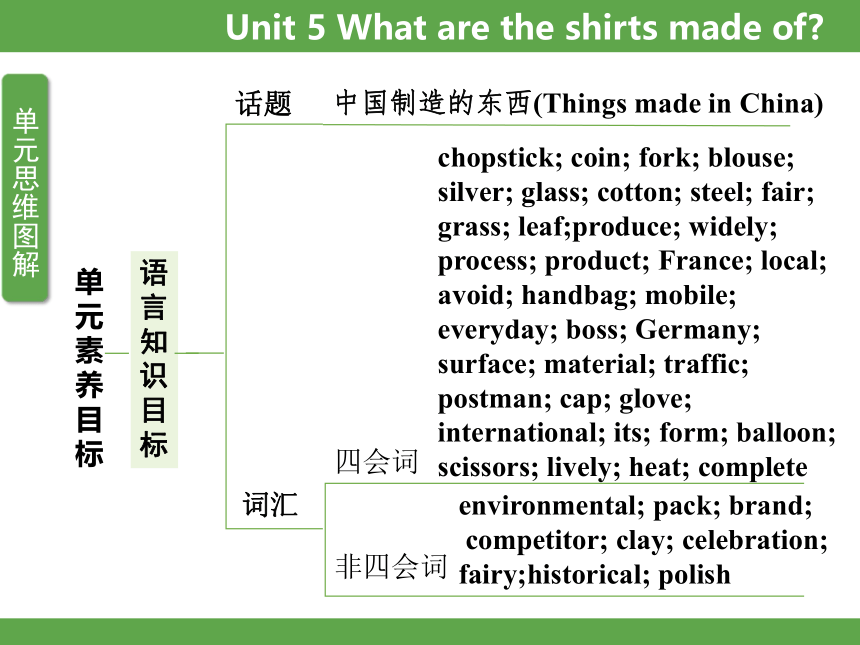 | |
| 格式 | pptx | ||
| 文件大小 | 378.7KB | ||
| 资源类型 | 教案 | ||
| 版本资源 | 人教新目标(Go for it)版 | ||
| 科目 | 英语 | ||
| 更新时间 | 2024-07-03 22:30:23 | ||
图片预览

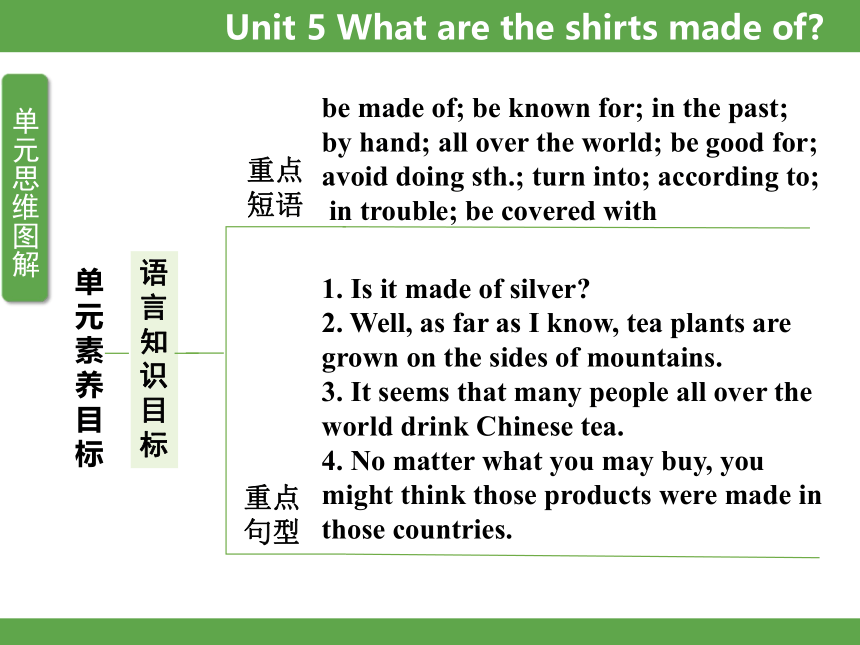

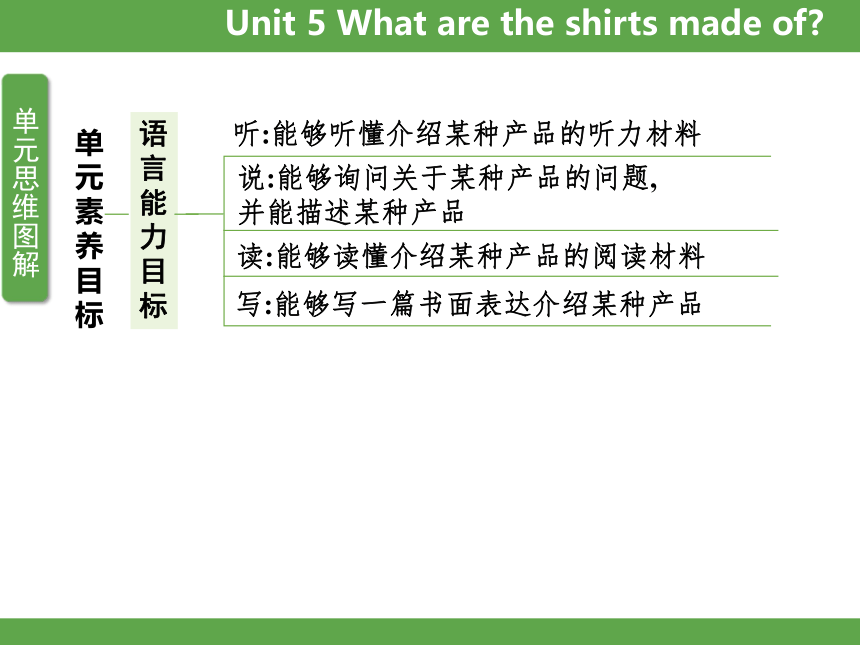
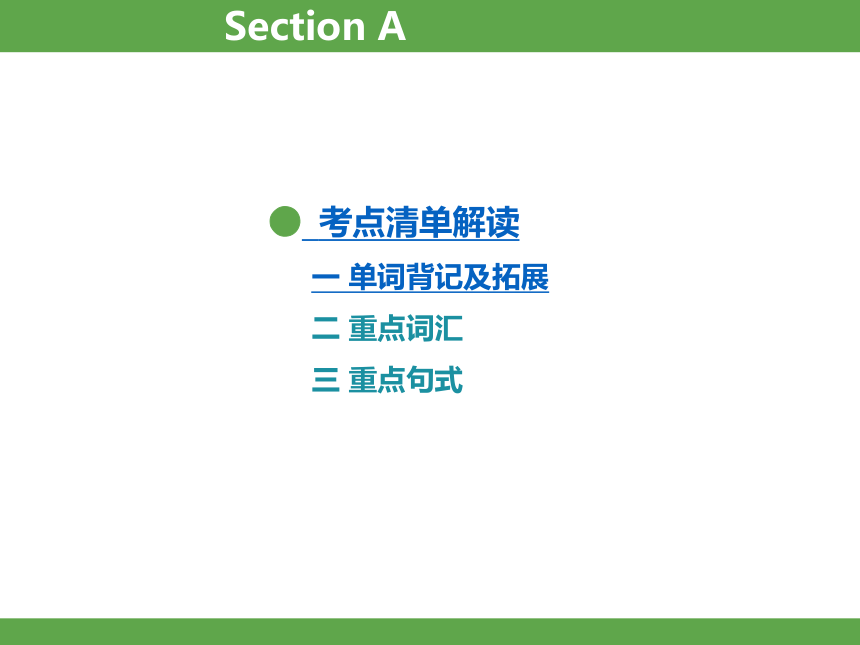
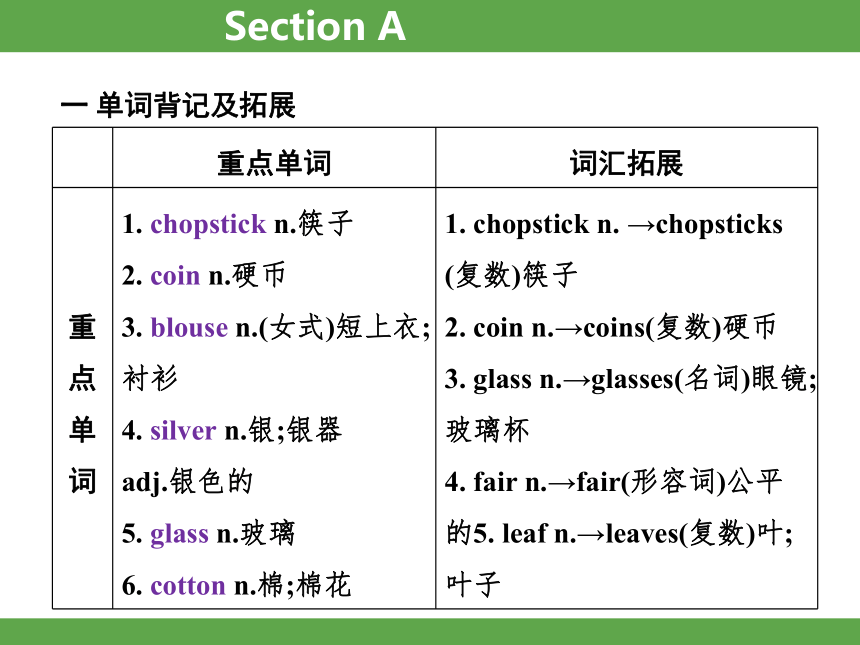
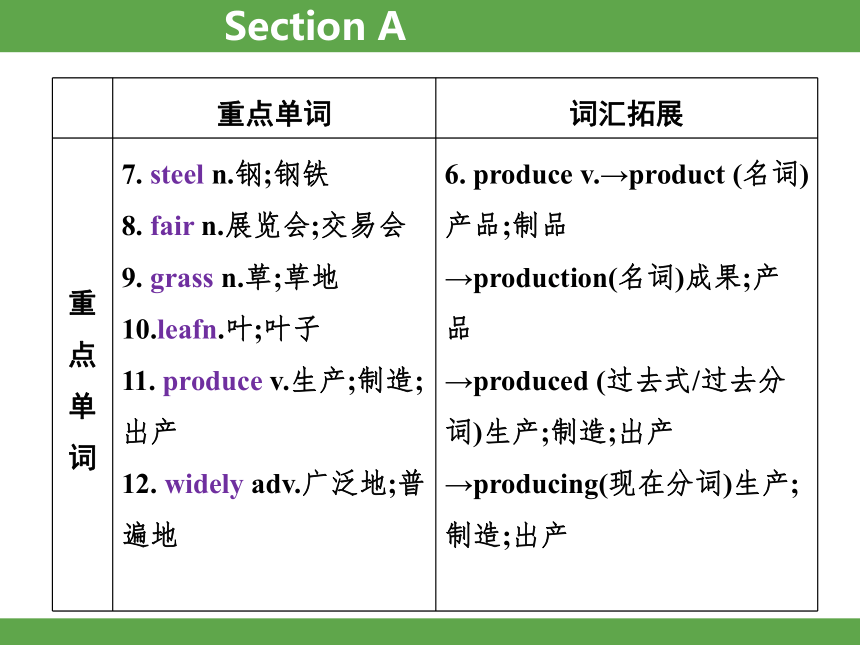
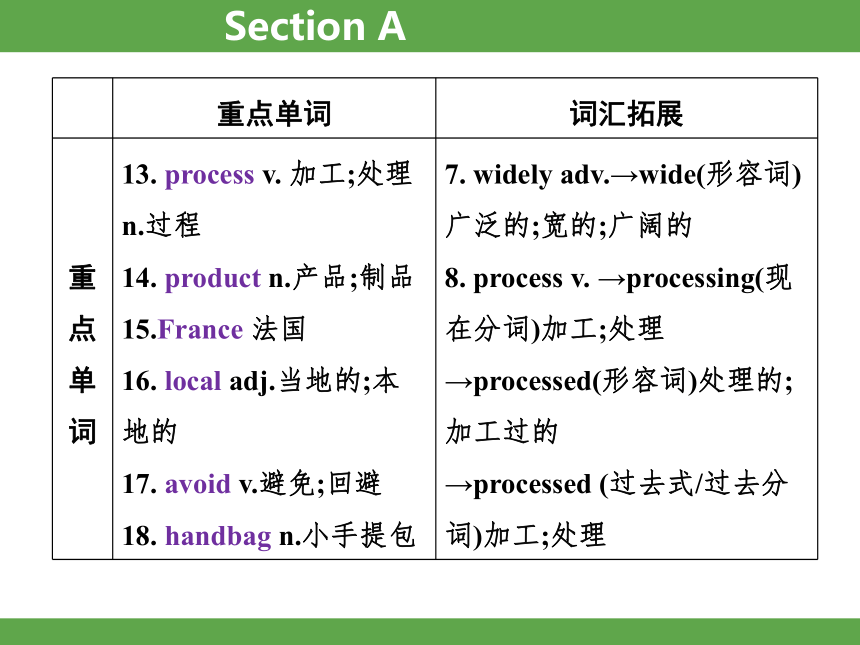
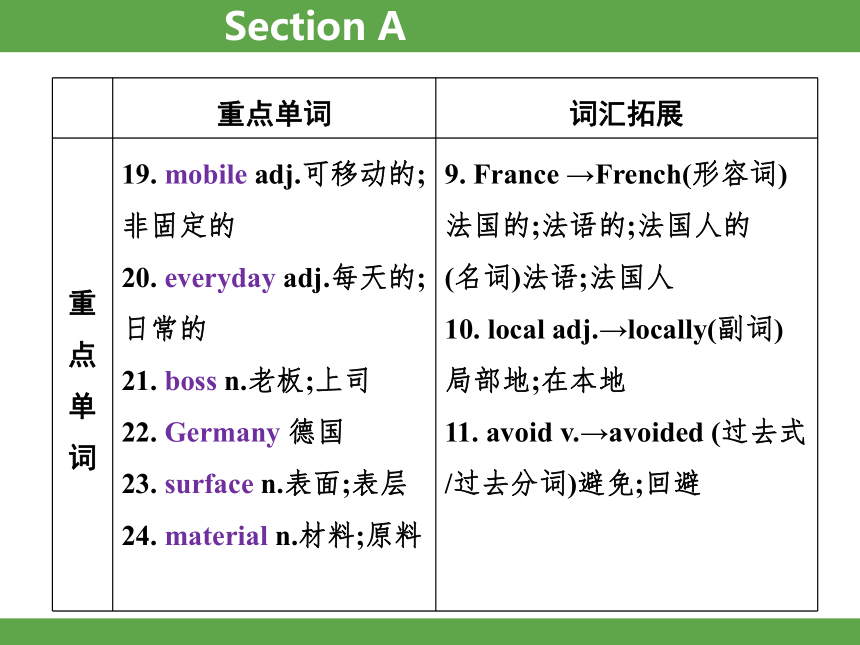
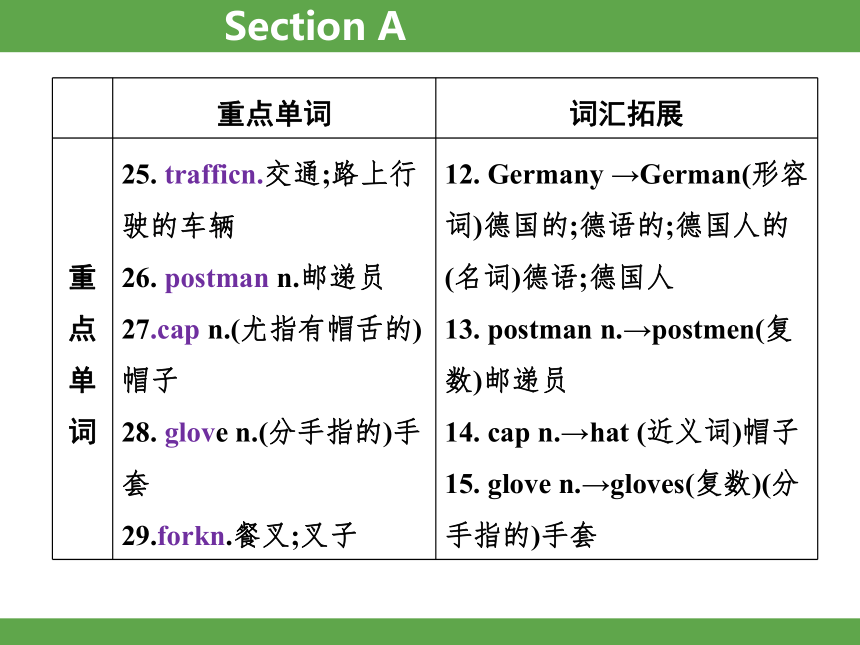
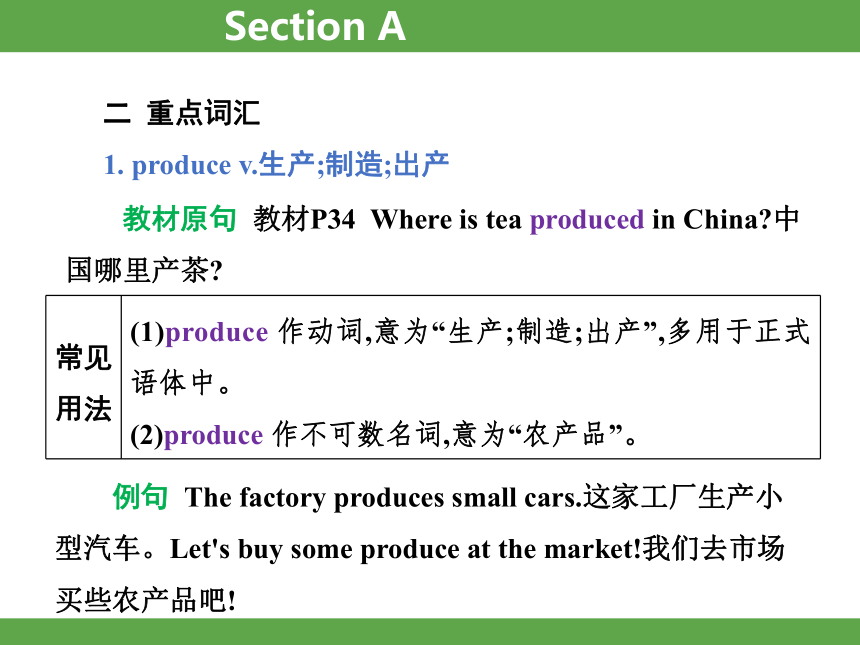
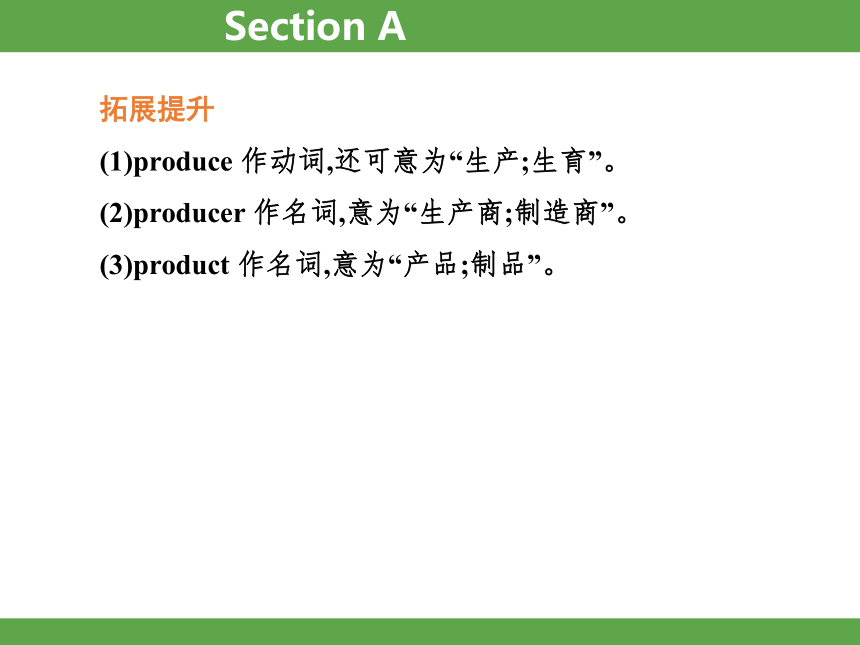
文档简介
(共63张PPT)
Unit 5 What are the shirts made of
语
言
知识目
标
单元素养目标
词汇
话题
中国制造的东西(Things made in China)
四会词
chopstick; coin; fork; blouse; silver; glass; cotton; steel; fair; grass; leaf;produce; widely; process; product; France; local; avoid; handbag; mobile;
everyday; boss; Germany; surface; material; traffic; postman; cap; glove;
international; its; form; balloon; scissors; lively; heat; complete
非四会词
environmental; pack; brand;
competitor; clay; celebration;
fairy;historical; polish
Unit 5 What are the shirts made of
语
言
知识目
标
单元素养目标
重点
短语
be made of; be known for; in the past;
by hand; all over the world; be good for;
avoid doing sth.; turn into; according to;
in trouble; be covered with
1. Is it made of silver
2. Well, as far as I know, tea plants are grown on the sides of mountains.
3. It seems that many people all over the world drink Chinese tea.
4. No matter what you may buy, you might think those products were made in those countries.
重点
句型
Unit 5 What are the shirts made of
语
言
知识目
标
单元素养目标
5. He found it interesting that so many
products in the local shops were made in
China.
6. These usually try to show the things that
are important in life, such as love,beauty
and family.
7. They are seen as bright symbols of
happiness and good wishes.
8. It takes several weeks to complete
everything.
重点
句型
语法
一般现在时的被动语态
Unit 5 What are the shirts made of
语言能力目标
单元素养目标
听:能够听懂介绍某种产品的听力材料
说:能够询问关于某种产品的问题,
并能描述某种产品
读:能够读懂介绍某种产品的阅读材料
写:能够写一篇书面表达介绍某种产品
● 考点清单解读
一 单词背记及拓展
二 重点词汇
三 重点句式
Section A
Section A
一 单词背记及拓展
重点单词 词汇拓展
重 点 单 词 1. chopstick n.筷子 2. coin n.硬币 3. blouse n.(女式)短上衣;衬衫 4. silver n.银;银器 adj.银色的 5. glass n.玻璃 6. cotton n.棉;棉花 1. chopstick n. →chopsticks (复数)筷子
2. coin n.→coins(复数)硬币
3. glass n.→glasses(名词)眼镜;玻璃杯
4. fair n.→fair(形容词)公平的5. leaf n.→leaves(复数)叶;叶子
Section A
重点单词 词汇拓展
重 点 单 词 7. steel n.钢;钢铁 8. fair n.展览会;交易会 9. grass n.草;草地 10.leafn.叶;叶子 11. produce v.生产;制造;出产 12. widely adv.广泛地;普遍地 6. produce v.→product (名词)产品;制品
→production(名词)成果;产品
→produced (过去式/过去分词)生产;制造;出产
→producing(现在分词)生产;制造;出产
Section A
重点单词 词汇拓展
重 点 单 词 13. process v. 加工;处理 n.过程 14. product n.产品;制品 15.France 法国 16. local adj.当地的;本地的 17. avoid v.避免;回避 18. handbag n.小手提包 7. widely adv.→wide(形容词)广泛的;宽的;广阔的
8. process v. →processing(现在分词)加工;处理
→processed(形容词)处理的;加工过的
→processed (过去式/过去分词)加工;处理
Section A
重点单词 词汇拓展
重 点 单 词 19. mobile adj.可移动的;非固定的 20. everyday adj.每天的;日常的 21. boss n.老板;上司 22. Germany 德国 23. surface n.表面;表层 24. material n.材料;原料 9. France →French(形容词)法国的;法语的;法国人的
(名词)法语;法国人
10. local adj.→locally(副词)局部地;在本地
11. avoid v.→avoided (过去式/过去分词)避免;回避
Section A
重点单词 词汇拓展
重 点 单 词 25. trafficn.交通;路上行驶的车辆 26. postman n.邮递员 27.cap n.(尤指有帽舌的)帽子 28. glove n.(分手指的)手套 29.forkn.餐叉;叉子 12. Germany →German(形容词)德国的;德语的;德国人的
(名词)德语;德国人
13. postman n.→postmen(复数)邮递员
14. cap n.→hat (近义词)帽子
15. glove n.→gloves(复数)(分手指的)手套
Section A
二 重点词汇
1. produce v.生产;制造;出产
常见用法 (1)produce 作动词,意为“生产;制造;出产”,多用于正式语体中。
(2)produce 作不可数名词,意为“农产品”。
教材原句 教材P34 Where is tea produced in China 中国哪里产茶
例句 The factory produces small cars.这家工厂生产小型汽车。Let's buy some produce at the market!我们去市场买些农产品吧!
Section A
拓展提升
(1)produce 作动词,还可意为“生产;生育”。
(2)producer 作名词,意为“生产商;制造商”。
(3)product 作名词,意为“产品;制品”。
Section A
2. widely adv.广泛地;普遍地
教材原句 教材P34 For example, Anxi and Hangzhou are widely known for their tea.例如,安溪和杭州因茶而被大家所熟知。
例句 His suggestions are widely accepted.他的建议得到了普遍认同。
常见用法 widely 为副词,意为“广泛地;普遍地”,是由形容词wide加副词后缀-ly构成的派生词。
Section A
拓展提升
wide 为形容词,意为“宽的,广泛的”,反义词
narrow 意为“窄的,狭窄的”。
如 :The river is too wide to swim across.
河面太宽了,游不过去。
Section A
3. avoid v.避免;回避
教材原句 教材P35 He realized that Americans can hardly avoid buying products made in China.他意识到美国人几乎无法避免买中国制造的产品。
常见用法 avoid作及物动词,意为“避免;回避”,后跟名词、代词或动词-ing形式作宾语,不能跟不定式作宾语。后面接动词-ing形式的动词还有:enjoy, suggest, keep, practice, finish, miss, mind等。
例句 You must avoid making the same mistake.你必须避免犯同样的错。
Section A
小助记
喜欢(enjoy)按照建议 (suggest)保持(keep)练习(practice),直到完成(finish),避免(avoid)错过(miss)任何内容引起老师介意(mind)。
Section A
4. be made of 由……制成
教材原句 教材P33 Is it made of silver 它是银制的吗
常见用法 be made of 表示“由……制成”。
看图 背例句 The table is made of wood, and paper is made from wood.桌子是用木材制成的,纸是由木材制成的。
Section A
易混辨析
be made of 由……制成,能够看出原材料
be made from 由……制成,看不出原材料
be made in 在某地制造
be made into 被制成……
be made by 由某人制造
Section A
5. be known for 以……闻名;为人知晓
教材原句 教材P34 For example, Anxi and Hangzhou are widely known for their tea.例如,安溪和杭州因茶而被大家所熟知。
常见用法 be known for 意为“以……闻名;为人知晓”,同义词组为be famous for。注意:for后面的宾语通常是主语本身所固有的东西。
Section A
看图 背例句 Korla, a beautiful city in Xinjiang, is known/ famous for its delicious pears.库尔勒,新疆一座美丽的城市,以美味的梨而著称。
Section A
易混辨析
(1)be known/ famous for“因……而闻名/著名”。
(2)be known/ famous as“以……(身份)而闻名,作为……而著名”。
(3)be known/ famous to“为……所熟知;对……而言是著名的”。如 :Edison is famous to the world. He is famous as an inventor and is famous for the light bulb.爱迪生为世人所熟知。他作为一位发明家而闻名,因灯泡而家喻户晓。
Section A
三 重点句式
1. no matter what的用法
教材原句 教材P35 No matter what you may buy, you might think those products were made in those countries.不论你可能会买什么东西,你或许会认为那些产品是在那些国家生产的。
句式结构 no matter what
常见用法 no matter what 表示“无论什么”,引导让步状语从句,此时可用whatever 替换。
Section A
例句 No matter what/ Whatever my mother cooks, it is my favorite. 无论妈妈做什么饭,都是我的最爱。
Section A
拓展提升
no matter 还可以构成的搭配:no matter
who=whoever无论谁;
no matter where=wherever无论在哪里;
no matter when =whenever 无论何时;
no matter how=however无论怎样。
Section A
2. seem 的用法
教材原句 教材P34 It seems that many people all over the world drink Chinese tea.似乎全世界很多人都喝中国茶。
常见用法 seem 意为“似乎;好像”,It seems that...表示“似乎……;好像……”。
例句 It seems that they don't like the presents.他们好像不喜欢这些礼物。
Section A
拓展提升
(1)It seems like...“似乎/好像……”,like 后常接名词。
(2)seem (+to be)+adj.似乎/好像……
(3)seem to do sth.似乎/好像做某事
Section A
3. found it +adj. +that...
教材原句 教材P35 He found it interesting that so many products in the local shops were made in China.他发现当地商店中如此多的产品都是中国制造的,这很有趣。
常见用法 句中it作形式宾语,真正的宾语是that引导的从句,在it作形式宾语的句式中,真正的宾语还可以是动词不定式短语。
例句 I found it strange that she didn't want to go.她居然不想去,我觉得奇怪。
Section A
拓展提升
it 在句中作形式宾语的其他句型
(1)find it+形容词+for sb.+to do sth.发现做某事对某人来说……
(2)make it+形容词+for sb.+to do sth.使做某事对某人来说……
● 考点清单解读
一 单词背记及拓展
二 重点词汇
三 重点句式
四 重点语法
Section B
Section B
一 单词背记及拓展
重点单词 词汇拓展
重 点 单 词 1. international adj.国际的 2. its pron. 它的 3. form n.形式;类型 4. balloon n.气球 5. scissors n.(pl.) 剪刀 6. lively adj.生气勃勃的;(色彩)鲜艳的 1. international adj. →national(对应词)国家的;民族的
2. its pron.→it (人称代词) 它
3. form n.→from (易混词)来自
4. balloon n. →balloons(复数)气球
Section B
重点单词 词汇拓展
重 点 单 词 7. heat n.热;高温 v.加热;变热 8. complete v.完成 5. lively adj.→live(动词)生活;居住;生存(形容词)活的;生动的;实况转播的
6. complete v. →completely(副词)完全地;彻底地.......
熟词生义
form作名词,还有“表格”之意。
Section B
二 重点词汇
1. lively adj.生气勃勃的;(色彩)鲜艳的
常见用法 lively 意为“生气勃勃的;(色彩)鲜艳的”,可作定语、表语或宾补,既可修饰人,又可修饰物。
教材原句 教材P38 The pieces are usually cute children or lively characters from a Chinese fairy tale or historical story.这些作品通常是可爱的孩子或是来自中国神话故事或历史故事中的生动的角色。
Section B
看图背例句
Young children are usually lively.
小孩子们通常是充满活力的。
They do a lively trade in souvenirs and gifts.
他们做纪念品和礼品生意,做得有声有色。
Section B
易混辨析
alive 意为“活(着)的”,侧重说明生与死之间的界限,既可修饰人,也可修饰物;可用作表语、后置定语或宾补。
living 意为“活着的”,强调“尚在人间;健在”,可用来修饰人或物;常用作定语或表语。
live 意为“活着的”,多修饰物,常用作定语,放在名词的前面。还指“实况转播的”。
lively 意为“生气勃勃的;(色彩)鲜艳的”,可作定语、表语或宾补,既可修饰人,又可修饰物。
Section B
2. complete v.完成
教材原句 教材P38 It takes several weeks to complete everything.完成这一系列工序要花费几周的时间。
常见用法 complete 意为“完成”,是及物动词,其后可接名词或代词作宾语。
例句 She completed the housework early in the morning.她一大早就把家务做完了。
Section B
拓展提升
complete 还可作形容词,意为“完整的;完全的”,其副词形式为completely。如:
Is this a complete story 这是一个完整的故事吗
Section B
3. according to根据;按照
教材原句 教材P38 According to Chinese history, sky lanterns were first used by Zhuge Kongming.据中国历史记载,孔明灯最早被诸葛孔明使用。
常见用法 according to是介词短语,意为“根据;按照”,后常跟名词或代词。
例句 According to the radio, it will rain tomorrow.据电台广播,明天有雨。
Section B
易错提示
according to 不适用于according to me 或according to my opinion/ view,但可以表达为 in my opinion/ view“依我看”。
Section B
4.( be ) in trouble处于困境中
教材原句 教材P38 He sent them out to ask for help when in trouble.他在遇到困难时会把它们放出去寻求帮助。
常见用法 in trouble 是固定搭配,意为“处于困境中”,trouble前不加任何冠词。
例句 Have you ever been in trouble before 你以前遭遇过困境吗
Section B
拓展提升
含有 trouble 的其他常见搭配:
get into trouble 陷入麻烦
out of trouble 摆脱困境
look for trouble自找麻烦
have trouble doing sth.做某事有困难
Section B
5. be covered with 由……覆盖;被……覆盖
教材原句 教材P38 They are made of bamboo and covered with paper.它们是用竹子制成的,外面用纸包着。
常见用法 be covered with 意为“由……覆盖;被……覆盖”,其中cover 表示“盖住;覆盖”。
例句 The playground was covered with snow.操场被雪覆盖了。
Section B
拓展提升
cover... with...是固定搭配,意为“用……覆盖……”。如:
You can cover the baby with your coat.你可以用你的外套盖住那个婴儿。
Section B
6. be seen as...被看作……;被视为……
教材原句 教材P38 They are seen as bright symbols of happiness and good wishes.它们被视作幸福和美好祝愿的鲜明象征。
常见用法 be seen as 表示“被看作……;被视为……”,为被动形式;主动形式为see... as...,意为“将……视为/看作……”。
例句 Red clothes are seen as good luck.红衣服被看作是好运的象征。
Section B
拓展提升
表示“被看作;被视为”还可以用be regarded as 或 be considered as,它们是同义表达。如:Chinese is regarded/ considered as the world's most difficult language.汉语被认为是世界上最难的语言。
Section B
三 重点句式
It takes/ took (sb.) some time to do sth.的句型结构
教材原句 教材P38 It takes several weeks to complete everything.完成这一系列工序要花费几周的时间。
常见用法 It takes/ took (sb.) some time to do sth.意为“做某事花费(某人)多少时间”。其中it为形式主语,真正的主语为后面的动词不定式。
例句 It takes me 15 minutes to get to school by bike.我骑自行车到学校需用15分钟。
Section B
拓展提升
It takes sb. some time to do sth.的句式结构可以 和 sb.spends some time doing sth.进行同义句转换。
如:It usually takes him half an hour to get to school.=He usually spends half an hour getting to school.他通常花半个小时到校。
Section B
四 重点语法
一般现在时的被动语态
教材原句 教材P36 How is tea produced 茶是怎样生产的
教材P36 Tea plants are grown on the sides of mountains.茶树被种植在山坡上。
Section B
常见用法
语态是动词的一种形式,表示主语和谓语动词之间的关系,分为主动语态和被动语态两种。主动语态表示主语是谓语动词所表示的动作的执行者;被动语态表示主语是谓语动词所表示的动作的承受者。被动语态由“be+及物动词的过去分词”构成。be本身无词义,但有时态、人称和数的变化。
Section B
被动语态主要用于下列几种情况:
(1)不知道动作的执行者是谁。如:This watch is made in China.这块手表是中国制造的。
(2)没有必要指出动作的执行者是谁。如:More trees must be planted every year.每年都必须种更多的树。
(3)需要强调或突出动作的承受者。如:Chinese is spoken by more and more people in the world.世界上越来越多的人说汉语。
(4)句子的主语是物。如:Many houses are washed away by the flood.很多房屋被洪水冲走了。
1.被动语态的用法
Section B
易错提示
1.主动语态变为被动语态的注意事项
(1) 部分使役动词变被动语态时要注意还原不定式符号to,且被动语态中的动作执行者可省略。
如:The boss makes us work 8 hours every day.老板让我们每天工作8个小时。
→We are made to work 8 hours every day.我们每天工作8个小时。
Section B
(2)含有双宾语,即直接宾语和间接宾语的句子,每个宾语都可变为被动语态的主语,即其被动语态有两种形式,但多以间接宾语作主语。
如:Jack tells us the truth.杰克告诉了我们真相。
→We are told the truth by Jack./The truth is told to us by Jack.真相是杰克告诉我们的。
Section B
2.动词的主动形式表示被动意义
以主动形式表示被动意义的动词多为连系动词,如:look,feel, smell 等。下列动词及短语没有被动形式:happen,cost,take place, have, sell。如:
An accident happened yesterday.昨天发生了一起事故。
The flower smells sweet.这朵花闻起来很香。
The watch looks very good.这块表看起来很好。
This book sells well.这本书很畅销。
Section B
一般现在时的被动语态的结构为“am/is/ are+及物动词的过去分词”,be的单复数形式根据主语而定。一般现在时的被动语态的各种句式如下:
2.一般现在时的被动语态的各种句式
Section B
句式 结构 例句
肯定句 主语+am/ is/ are+过去分词(+by...). Many people are killed in
traffic accidents every year.
每年有很多人死于交通事故。
否定句 主语+am/ is/ are +not+过去分词(+by...). English isn't spoken by people here.
这里的人不说英语。
Section B
一般疑 问句 Am/ Is/ Are+主语+过 去分词(+by...) Are the cars made in China
这些汽车是中国生产的吗
特殊疑 问句 疑问词+am/ is/ are(+ 主语)+过去分词(+ by...) What is this kind of sweater made of
这种毛衣是用什么制成的
Section B
3.主动语态变被动语态
规则 例句
把主动语态的宾语变 为被动语态的主语 They make the bikes in the factory.
→The bikes are made by them in the factory.
他们在工厂里制造自行车。
把主动结构的谓语动 词变为被动结构(be+ 过去分词) He waters these young trees every two days.→These young trees are watered by him every two days.
他每两天就给这些小树浇水。
Section B
规则 例句
把主动语态的主语变 为介词by的宾语,组 成介词短语 The teacher often praises him.
→He is often praised by the teacher.他经常受到老师的表扬。
注意 主动语态的主语若是人称代词主格,在被动结构中要变为宾格。
例句 They often laugh at him.→He is often laughed at by them. 他们经常嘲笑他。
语篇考法精讲
句子排序题解题技巧
典例剖析
As Xiong Chuanfa, 34,blew a lifelike puppy out of molten maltose (溶化的麦芽糖)in just minutes, kids looked carefully at him with great surprise, thinking he was a magician.
Xiong Chuanfa has been working on blowing sugar figurines, a Chinese traditional folk art with a history of over 600 years, for more than twenty years.
语篇考法精讲
In this special art form, the artist heats the syrup (糖浆) to acertain temperature, pulls off a small amount, makes it into a ball with an open center, presses the open area together and stretches it to form a tube. Then he blows air into the tube and makes it into different shapes. The traditional folk art has been listed as a state-level intangible cultural heritage(非物质文化遗产).
语篇考法精讲
[中考新考法·句子排序]
What is the correct order of making sugar figurines
a. Making it into a sugar ball.
b. Stretching it to make a tube.
c. Pulling off some heated syrup.
d. Blowing air to make wanted shapes.
A. c-a-b-d
B. c-b-a-d
C. b-a-c-d
D. b-c-a-d
语篇考法精讲
[解析]根据文中内容可知,艺术家将糖浆加热到一定的温度,取出少量,把它做成一个中心开放的球,将开放的区域压在一起,拉伸成一根管子,然后他把空气吹进管子里,把它做成不同的形状。所以顺序是c-a-b-d,故选A。
[答案] A
语篇考法精讲
考法说明
句子排序题通常是把几个句子从一定的语境中提取出来,有意打乱其顺序,设计试题,让学生重新排序。常见的设问方式有:
What is the correct order
according to the text
Which of the following is the correct order of...
语篇考法精讲
技巧点拨
解答此类试题可采用定位排序法,具体步骤如下:
1.根据题干选项中的关键词在文章中定位关键信息。
2.根据文章发展脉络,结合时间顺序和空间顺序,对关键信息点进行排序。
3.根据排序结果,选择对应的答案。
Unit 5 What are the shirts made of
语
言
知识目
标
单元素养目标
词汇
话题
中国制造的东西(Things made in China)
四会词
chopstick; coin; fork; blouse; silver; glass; cotton; steel; fair; grass; leaf;produce; widely; process; product; France; local; avoid; handbag; mobile;
everyday; boss; Germany; surface; material; traffic; postman; cap; glove;
international; its; form; balloon; scissors; lively; heat; complete
非四会词
environmental; pack; brand;
competitor; clay; celebration;
fairy;historical; polish
Unit 5 What are the shirts made of
语
言
知识目
标
单元素养目标
重点
短语
be made of; be known for; in the past;
by hand; all over the world; be good for;
avoid doing sth.; turn into; according to;
in trouble; be covered with
1. Is it made of silver
2. Well, as far as I know, tea plants are grown on the sides of mountains.
3. It seems that many people all over the world drink Chinese tea.
4. No matter what you may buy, you might think those products were made in those countries.
重点
句型
Unit 5 What are the shirts made of
语
言
知识目
标
单元素养目标
5. He found it interesting that so many
products in the local shops were made in
China.
6. These usually try to show the things that
are important in life, such as love,beauty
and family.
7. They are seen as bright symbols of
happiness and good wishes.
8. It takes several weeks to complete
everything.
重点
句型
语法
一般现在时的被动语态
Unit 5 What are the shirts made of
语言能力目标
单元素养目标
听:能够听懂介绍某种产品的听力材料
说:能够询问关于某种产品的问题,
并能描述某种产品
读:能够读懂介绍某种产品的阅读材料
写:能够写一篇书面表达介绍某种产品
● 考点清单解读
一 单词背记及拓展
二 重点词汇
三 重点句式
Section A
Section A
一 单词背记及拓展
重点单词 词汇拓展
重 点 单 词 1. chopstick n.筷子 2. coin n.硬币 3. blouse n.(女式)短上衣;衬衫 4. silver n.银;银器 adj.银色的 5. glass n.玻璃 6. cotton n.棉;棉花 1. chopstick n. →chopsticks (复数)筷子
2. coin n.→coins(复数)硬币
3. glass n.→glasses(名词)眼镜;玻璃杯
4. fair n.→fair(形容词)公平的5. leaf n.→leaves(复数)叶;叶子
Section A
重点单词 词汇拓展
重 点 单 词 7. steel n.钢;钢铁 8. fair n.展览会;交易会 9. grass n.草;草地 10.leafn.叶;叶子 11. produce v.生产;制造;出产 12. widely adv.广泛地;普遍地 6. produce v.→product (名词)产品;制品
→production(名词)成果;产品
→produced (过去式/过去分词)生产;制造;出产
→producing(现在分词)生产;制造;出产
Section A
重点单词 词汇拓展
重 点 单 词 13. process v. 加工;处理 n.过程 14. product n.产品;制品 15.France 法国 16. local adj.当地的;本地的 17. avoid v.避免;回避 18. handbag n.小手提包 7. widely adv.→wide(形容词)广泛的;宽的;广阔的
8. process v. →processing(现在分词)加工;处理
→processed(形容词)处理的;加工过的
→processed (过去式/过去分词)加工;处理
Section A
重点单词 词汇拓展
重 点 单 词 19. mobile adj.可移动的;非固定的 20. everyday adj.每天的;日常的 21. boss n.老板;上司 22. Germany 德国 23. surface n.表面;表层 24. material n.材料;原料 9. France →French(形容词)法国的;法语的;法国人的
(名词)法语;法国人
10. local adj.→locally(副词)局部地;在本地
11. avoid v.→avoided (过去式/过去分词)避免;回避
Section A
重点单词 词汇拓展
重 点 单 词 25. trafficn.交通;路上行驶的车辆 26. postman n.邮递员 27.cap n.(尤指有帽舌的)帽子 28. glove n.(分手指的)手套 29.forkn.餐叉;叉子 12. Germany →German(形容词)德国的;德语的;德国人的
(名词)德语;德国人
13. postman n.→postmen(复数)邮递员
14. cap n.→hat (近义词)帽子
15. glove n.→gloves(复数)(分手指的)手套
Section A
二 重点词汇
1. produce v.生产;制造;出产
常见用法 (1)produce 作动词,意为“生产;制造;出产”,多用于正式语体中。
(2)produce 作不可数名词,意为“农产品”。
教材原句 教材P34 Where is tea produced in China 中国哪里产茶
例句 The factory produces small cars.这家工厂生产小型汽车。Let's buy some produce at the market!我们去市场买些农产品吧!
Section A
拓展提升
(1)produce 作动词,还可意为“生产;生育”。
(2)producer 作名词,意为“生产商;制造商”。
(3)product 作名词,意为“产品;制品”。
Section A
2. widely adv.广泛地;普遍地
教材原句 教材P34 For example, Anxi and Hangzhou are widely known for their tea.例如,安溪和杭州因茶而被大家所熟知。
例句 His suggestions are widely accepted.他的建议得到了普遍认同。
常见用法 widely 为副词,意为“广泛地;普遍地”,是由形容词wide加副词后缀-ly构成的派生词。
Section A
拓展提升
wide 为形容词,意为“宽的,广泛的”,反义词
narrow 意为“窄的,狭窄的”。
如 :The river is too wide to swim across.
河面太宽了,游不过去。
Section A
3. avoid v.避免;回避
教材原句 教材P35 He realized that Americans can hardly avoid buying products made in China.他意识到美国人几乎无法避免买中国制造的产品。
常见用法 avoid作及物动词,意为“避免;回避”,后跟名词、代词或动词-ing形式作宾语,不能跟不定式作宾语。后面接动词-ing形式的动词还有:enjoy, suggest, keep, practice, finish, miss, mind等。
例句 You must avoid making the same mistake.你必须避免犯同样的错。
Section A
小助记
喜欢(enjoy)按照建议 (suggest)保持(keep)练习(practice),直到完成(finish),避免(avoid)错过(miss)任何内容引起老师介意(mind)。
Section A
4. be made of 由……制成
教材原句 教材P33 Is it made of silver 它是银制的吗
常见用法 be made of 表示“由……制成”。
看图 背例句 The table is made of wood, and paper is made from wood.桌子是用木材制成的,纸是由木材制成的。
Section A
易混辨析
be made of 由……制成,能够看出原材料
be made from 由……制成,看不出原材料
be made in 在某地制造
be made into 被制成……
be made by 由某人制造
Section A
5. be known for 以……闻名;为人知晓
教材原句 教材P34 For example, Anxi and Hangzhou are widely known for their tea.例如,安溪和杭州因茶而被大家所熟知。
常见用法 be known for 意为“以……闻名;为人知晓”,同义词组为be famous for。注意:for后面的宾语通常是主语本身所固有的东西。
Section A
看图 背例句 Korla, a beautiful city in Xinjiang, is known/ famous for its delicious pears.库尔勒,新疆一座美丽的城市,以美味的梨而著称。
Section A
易混辨析
(1)be known/ famous for“因……而闻名/著名”。
(2)be known/ famous as“以……(身份)而闻名,作为……而著名”。
(3)be known/ famous to“为……所熟知;对……而言是著名的”。如 :Edison is famous to the world. He is famous as an inventor and is famous for the light bulb.爱迪生为世人所熟知。他作为一位发明家而闻名,因灯泡而家喻户晓。
Section A
三 重点句式
1. no matter what的用法
教材原句 教材P35 No matter what you may buy, you might think those products were made in those countries.不论你可能会买什么东西,你或许会认为那些产品是在那些国家生产的。
句式结构 no matter what
常见用法 no matter what 表示“无论什么”,引导让步状语从句,此时可用whatever 替换。
Section A
例句 No matter what/ Whatever my mother cooks, it is my favorite. 无论妈妈做什么饭,都是我的最爱。
Section A
拓展提升
no matter 还可以构成的搭配:no matter
who=whoever无论谁;
no matter where=wherever无论在哪里;
no matter when =whenever 无论何时;
no matter how=however无论怎样。
Section A
2. seem 的用法
教材原句 教材P34 It seems that many people all over the world drink Chinese tea.似乎全世界很多人都喝中国茶。
常见用法 seem 意为“似乎;好像”,It seems that...表示“似乎……;好像……”。
例句 It seems that they don't like the presents.他们好像不喜欢这些礼物。
Section A
拓展提升
(1)It seems like...“似乎/好像……”,like 后常接名词。
(2)seem (+to be)+adj.似乎/好像……
(3)seem to do sth.似乎/好像做某事
Section A
3. found it +adj. +that...
教材原句 教材P35 He found it interesting that so many products in the local shops were made in China.他发现当地商店中如此多的产品都是中国制造的,这很有趣。
常见用法 句中it作形式宾语,真正的宾语是that引导的从句,在it作形式宾语的句式中,真正的宾语还可以是动词不定式短语。
例句 I found it strange that she didn't want to go.她居然不想去,我觉得奇怪。
Section A
拓展提升
it 在句中作形式宾语的其他句型
(1)find it+形容词+for sb.+to do sth.发现做某事对某人来说……
(2)make it+形容词+for sb.+to do sth.使做某事对某人来说……
● 考点清单解读
一 单词背记及拓展
二 重点词汇
三 重点句式
四 重点语法
Section B
Section B
一 单词背记及拓展
重点单词 词汇拓展
重 点 单 词 1. international adj.国际的 2. its pron. 它的 3. form n.形式;类型 4. balloon n.气球 5. scissors n.(pl.) 剪刀 6. lively adj.生气勃勃的;(色彩)鲜艳的 1. international adj. →national(对应词)国家的;民族的
2. its pron.→it (人称代词) 它
3. form n.→from (易混词)来自
4. balloon n. →balloons(复数)气球
Section B
重点单词 词汇拓展
重 点 单 词 7. heat n.热;高温 v.加热;变热 8. complete v.完成 5. lively adj.→live(动词)生活;居住;生存(形容词)活的;生动的;实况转播的
6. complete v. →completely(副词)完全地;彻底地.......
熟词生义
form作名词,还有“表格”之意。
Section B
二 重点词汇
1. lively adj.生气勃勃的;(色彩)鲜艳的
常见用法 lively 意为“生气勃勃的;(色彩)鲜艳的”,可作定语、表语或宾补,既可修饰人,又可修饰物。
教材原句 教材P38 The pieces are usually cute children or lively characters from a Chinese fairy tale or historical story.这些作品通常是可爱的孩子或是来自中国神话故事或历史故事中的生动的角色。
Section B
看图背例句
Young children are usually lively.
小孩子们通常是充满活力的。
They do a lively trade in souvenirs and gifts.
他们做纪念品和礼品生意,做得有声有色。
Section B
易混辨析
alive 意为“活(着)的”,侧重说明生与死之间的界限,既可修饰人,也可修饰物;可用作表语、后置定语或宾补。
living 意为“活着的”,强调“尚在人间;健在”,可用来修饰人或物;常用作定语或表语。
live 意为“活着的”,多修饰物,常用作定语,放在名词的前面。还指“实况转播的”。
lively 意为“生气勃勃的;(色彩)鲜艳的”,可作定语、表语或宾补,既可修饰人,又可修饰物。
Section B
2. complete v.完成
教材原句 教材P38 It takes several weeks to complete everything.完成这一系列工序要花费几周的时间。
常见用法 complete 意为“完成”,是及物动词,其后可接名词或代词作宾语。
例句 She completed the housework early in the morning.她一大早就把家务做完了。
Section B
拓展提升
complete 还可作形容词,意为“完整的;完全的”,其副词形式为completely。如:
Is this a complete story 这是一个完整的故事吗
Section B
3. according to根据;按照
教材原句 教材P38 According to Chinese history, sky lanterns were first used by Zhuge Kongming.据中国历史记载,孔明灯最早被诸葛孔明使用。
常见用法 according to是介词短语,意为“根据;按照”,后常跟名词或代词。
例句 According to the radio, it will rain tomorrow.据电台广播,明天有雨。
Section B
易错提示
according to 不适用于according to me 或according to my opinion/ view,但可以表达为 in my opinion/ view“依我看”。
Section B
4.( be ) in trouble处于困境中
教材原句 教材P38 He sent them out to ask for help when in trouble.他在遇到困难时会把它们放出去寻求帮助。
常见用法 in trouble 是固定搭配,意为“处于困境中”,trouble前不加任何冠词。
例句 Have you ever been in trouble before 你以前遭遇过困境吗
Section B
拓展提升
含有 trouble 的其他常见搭配:
get into trouble 陷入麻烦
out of trouble 摆脱困境
look for trouble自找麻烦
have trouble doing sth.做某事有困难
Section B
5. be covered with 由……覆盖;被……覆盖
教材原句 教材P38 They are made of bamboo and covered with paper.它们是用竹子制成的,外面用纸包着。
常见用法 be covered with 意为“由……覆盖;被……覆盖”,其中cover 表示“盖住;覆盖”。
例句 The playground was covered with snow.操场被雪覆盖了。
Section B
拓展提升
cover... with...是固定搭配,意为“用……覆盖……”。如:
You can cover the baby with your coat.你可以用你的外套盖住那个婴儿。
Section B
6. be seen as...被看作……;被视为……
教材原句 教材P38 They are seen as bright symbols of happiness and good wishes.它们被视作幸福和美好祝愿的鲜明象征。
常见用法 be seen as 表示“被看作……;被视为……”,为被动形式;主动形式为see... as...,意为“将……视为/看作……”。
例句 Red clothes are seen as good luck.红衣服被看作是好运的象征。
Section B
拓展提升
表示“被看作;被视为”还可以用be regarded as 或 be considered as,它们是同义表达。如:Chinese is regarded/ considered as the world's most difficult language.汉语被认为是世界上最难的语言。
Section B
三 重点句式
It takes/ took (sb.) some time to do sth.的句型结构
教材原句 教材P38 It takes several weeks to complete everything.完成这一系列工序要花费几周的时间。
常见用法 It takes/ took (sb.) some time to do sth.意为“做某事花费(某人)多少时间”。其中it为形式主语,真正的主语为后面的动词不定式。
例句 It takes me 15 minutes to get to school by bike.我骑自行车到学校需用15分钟。
Section B
拓展提升
It takes sb. some time to do sth.的句式结构可以 和 sb.spends some time doing sth.进行同义句转换。
如:It usually takes him half an hour to get to school.=He usually spends half an hour getting to school.他通常花半个小时到校。
Section B
四 重点语法
一般现在时的被动语态
教材原句 教材P36 How is tea produced 茶是怎样生产的
教材P36 Tea plants are grown on the sides of mountains.茶树被种植在山坡上。
Section B
常见用法
语态是动词的一种形式,表示主语和谓语动词之间的关系,分为主动语态和被动语态两种。主动语态表示主语是谓语动词所表示的动作的执行者;被动语态表示主语是谓语动词所表示的动作的承受者。被动语态由“be+及物动词的过去分词”构成。be本身无词义,但有时态、人称和数的变化。
Section B
被动语态主要用于下列几种情况:
(1)不知道动作的执行者是谁。如:This watch is made in China.这块手表是中国制造的。
(2)没有必要指出动作的执行者是谁。如:More trees must be planted every year.每年都必须种更多的树。
(3)需要强调或突出动作的承受者。如:Chinese is spoken by more and more people in the world.世界上越来越多的人说汉语。
(4)句子的主语是物。如:Many houses are washed away by the flood.很多房屋被洪水冲走了。
1.被动语态的用法
Section B
易错提示
1.主动语态变为被动语态的注意事项
(1) 部分使役动词变被动语态时要注意还原不定式符号to,且被动语态中的动作执行者可省略。
如:The boss makes us work 8 hours every day.老板让我们每天工作8个小时。
→We are made to work 8 hours every day.我们每天工作8个小时。
Section B
(2)含有双宾语,即直接宾语和间接宾语的句子,每个宾语都可变为被动语态的主语,即其被动语态有两种形式,但多以间接宾语作主语。
如:Jack tells us the truth.杰克告诉了我们真相。
→We are told the truth by Jack./The truth is told to us by Jack.真相是杰克告诉我们的。
Section B
2.动词的主动形式表示被动意义
以主动形式表示被动意义的动词多为连系动词,如:look,feel, smell 等。下列动词及短语没有被动形式:happen,cost,take place, have, sell。如:
An accident happened yesterday.昨天发生了一起事故。
The flower smells sweet.这朵花闻起来很香。
The watch looks very good.这块表看起来很好。
This book sells well.这本书很畅销。
Section B
一般现在时的被动语态的结构为“am/is/ are+及物动词的过去分词”,be的单复数形式根据主语而定。一般现在时的被动语态的各种句式如下:
2.一般现在时的被动语态的各种句式
Section B
句式 结构 例句
肯定句 主语+am/ is/ are+过去分词(+by...). Many people are killed in
traffic accidents every year.
每年有很多人死于交通事故。
否定句 主语+am/ is/ are +not+过去分词(+by...). English isn't spoken by people here.
这里的人不说英语。
Section B
一般疑 问句 Am/ Is/ Are+主语+过 去分词(+by...) Are the cars made in China
这些汽车是中国生产的吗
特殊疑 问句 疑问词+am/ is/ are(+ 主语)+过去分词(+ by...) What is this kind of sweater made of
这种毛衣是用什么制成的
Section B
3.主动语态变被动语态
规则 例句
把主动语态的宾语变 为被动语态的主语 They make the bikes in the factory.
→The bikes are made by them in the factory.
他们在工厂里制造自行车。
把主动结构的谓语动 词变为被动结构(be+ 过去分词) He waters these young trees every two days.→These young trees are watered by him every two days.
他每两天就给这些小树浇水。
Section B
规则 例句
把主动语态的主语变 为介词by的宾语,组 成介词短语 The teacher often praises him.
→He is often praised by the teacher.他经常受到老师的表扬。
注意 主动语态的主语若是人称代词主格,在被动结构中要变为宾格。
例句 They often laugh at him.→He is often laughed at by them. 他们经常嘲笑他。
语篇考法精讲
句子排序题解题技巧
典例剖析
As Xiong Chuanfa, 34,blew a lifelike puppy out of molten maltose (溶化的麦芽糖)in just minutes, kids looked carefully at him with great surprise, thinking he was a magician.
Xiong Chuanfa has been working on blowing sugar figurines, a Chinese traditional folk art with a history of over 600 years, for more than twenty years.
语篇考法精讲
In this special art form, the artist heats the syrup (糖浆) to acertain temperature, pulls off a small amount, makes it into a ball with an open center, presses the open area together and stretches it to form a tube. Then he blows air into the tube and makes it into different shapes. The traditional folk art has been listed as a state-level intangible cultural heritage(非物质文化遗产).
语篇考法精讲
[中考新考法·句子排序]
What is the correct order of making sugar figurines
a. Making it into a sugar ball.
b. Stretching it to make a tube.
c. Pulling off some heated syrup.
d. Blowing air to make wanted shapes.
A. c-a-b-d
B. c-b-a-d
C. b-a-c-d
D. b-c-a-d
语篇考法精讲
[解析]根据文中内容可知,艺术家将糖浆加热到一定的温度,取出少量,把它做成一个中心开放的球,将开放的区域压在一起,拉伸成一根管子,然后他把空气吹进管子里,把它做成不同的形状。所以顺序是c-a-b-d,故选A。
[答案] A
语篇考法精讲
考法说明
句子排序题通常是把几个句子从一定的语境中提取出来,有意打乱其顺序,设计试题,让学生重新排序。常见的设问方式有:
What is the correct order
according to the text
Which of the following is the correct order of...
语篇考法精讲
技巧点拨
解答此类试题可采用定位排序法,具体步骤如下:
1.根据题干选项中的关键词在文章中定位关键信息。
2.根据文章发展脉络,结合时间顺序和空间顺序,对关键信息点进行排序。
3.根据排序结果,选择对应的答案。
同课章节目录
- Unit 1 How can we become good learners.
- Section A
- Section B
- Unit 2 I think that mooncakes are delicious!
- Section A
- Section B
- Unit 3 Could you please tell me where the restroom
- Section A
- Section B
- Unit 4 I used to be afraid of the dark.
- Section A
- Section B
- Unit 5 What are the shirts made of?
- Section A
- Section B
- Review of Units 1-5
- Unit 6 When was it invented?
- Section A
- Section B
- Unit 7 Teenagers should be allowed to choose their
- Section A
- Section B
- Unit 8 It must belong to Carla.
- Section A
- Section B
- Unit 9 I like music that I can dance to.
- Section A
- Section B
- Unit 10 You're supposed to shake hands.
- Section A
- Section B
- Review of Units 6-10
- Unit 11 Sad movies make me cry.
- Section A
- Section B
- Unit 12 Life is full of the unexpected
- Section A
- Section B
- Unit 13 We're trying to save the earth!
- Section A
- Section B
- Unit 14 I remember meeting all of you in Grade 7.
- Section A
- Section B
- Review of Units 11-14
